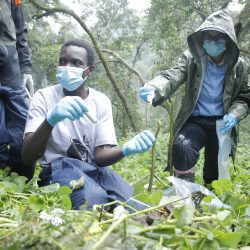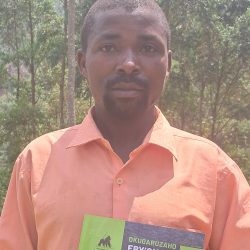Amazing Humba!
Blog | 29/05/09
This is Eugene Rutagarama, Director of IGCP. I have worked for gorillas for quite a while, but visiting them never ceases to be a fascinating experience.
Last Thursday, together with some colleagues, I had another amazing gorilla visit, checking in with the Humba group in the Democratic Republic of Congo in the Mikeno sector of Virunga National Park. This visit was significant not only because of the beauty of the area, but also because I was able to visit the 12 strong Humba family and to witness how the local communities are reaping the benefit of the current calm after several months of unrest.
We started our trip from Goma, located right on the border of Rwanda, proceeding to the Bukima park site early in the morning. Bukima is the stepping off point for visits to Humba and two other local gorilla groups.
A bumpy ride on the road from the Park headquarters at Rumangabo to Bukima is akin to a rough massage session for the back, but even my old back made it! Fortunately, this difficult road is currently under rehabilitation thanks to the Greater Virunga Transboundary Executive Secretariat (which makes up the three gorilla range countries of DRC, Uganda and Rwanda) support to ICCN (The Congo government’s institute for nature conservation).
The day was fantastic! The Bukima site stunningly overlooks what seems like half of Eastern Congo, with an open panorama revealing a breathtaking scenic view of five of the eight main Virunga volcanoes: Karisimbi, Mikeno, Bisoke, Nyiragongo and Nyamulagira.
We picked up our guide, Mr. Didi, a Park veteran, at Rumangabo. A very confident guide, he was fully in charge all the way and very responsive to our numerous queries.
From the Bukima site, the trek was three kilometers to the Park entry point. On the way, we chatted with a community member who was a recent victim of gorilla crop raiding. She was angry for having lost a portion of her cornfield during the previous night. She reported to us that despite the noise she made to chase them away, the gorillas wouldn’t move from her field.We consoled her with encouraging words, though we knew that a conclusive solution to this complex problem will take some time.
We learned from Didi that the Silverback Humba, after which this family was named, has gotten into the habit of raiding crops from his mother’s family, the Rugendo group, which is also known for its forays onto community land outside of the park The Rugendo group was victim of the infamous premeditated murder attack reported worldwide in July 2007, when it lost seven individuals to gunshot wounds.
As we entered the Park, I realized we need to strengthen even further IGCP’s commitment to both human and gorilla communities in the area, and continue working on new solutions to human-gorilla conflict.
It only took 500 meters or so to come face to face with the Humba group in very dense vegetation. The boss of the group, the silverback Humba was resting quietly, lying on his back, while the adult female named Magori was nearby, together with her young male offspring, Semakuba. The latter is a very stubborn young guy! He tried to approach and play with us as if we were best friends from way back! Didi intervened softly, however, to “ask him” to allow us to proceed to the thicket of bushes where Magori was also sitting thoughtfully.
Just then, Humba moved from the place where he was lying down and started eating. This guy had an amazing appetite! He would tear off a liana vine and peel it methodically before swallowing its skin and pulpy contents. He gluttonously gulped down dozens of young vines this way in a matter of a few minutes, while also keeping a vigilant eye on us, showing a bit of agitation from time to time whenever we stood up to get a better view. Noticing such agitation, I sat down and started simulating eating a leaf. When the true boss felt in charge again, he cooled down.
Time gets lost when watching gorillas, and when we finally started thinking of moving from Humba to see other members of the group, our strictly enforced hour visit had already passed. We realized that Humba had almost hypnotized us, showing off his charisma and prodigious eating talents long enough to keep us entranced for the better part of sixty minutes.
My work has allowed me to see gorillas many times in the three mountain gorilla range countries, but every visit for me is a special and new experience. This experience in the Congo was no different, made all the more extraordinary due to the fact that we were able to make it here in the first place.
Five months ago this area was overrun with militias, conflict and suffering on a grand scale. Today, we can see Humba and his crew, peacefully chewing their way through the dense green carpet which blankets Mikeno Volcano’s lower slopes. If peace continues to overcome the dark days of war and suffering, perhaps one day soon others will be able to visit a healthy Humba family and this exceedingly wild and beautiful corner of Eastern Congo.
No matter where the location, however, there is one commonality that always seems to catch my attention during these experiences with gorillas: their eyes. Gorilla eyes seem to always tell me something. See the face of Magori below, and find your own meaning…





